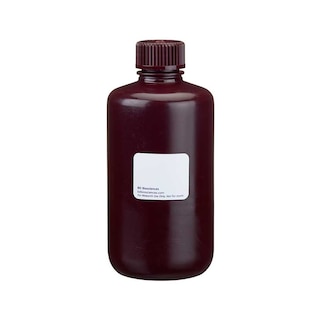Old Browser
Looks like you're visiting us from {countryName}.
Would you like to stay on the current country site or be switched to your country?


.png)

Analysis of TIE2 (pY1102) in human vascular endothelium. EA-hy 926 cells (Edgell, McDonald, Graham, 1983, left panel) were serum starved overnight, detached using 1X trypsin, washed, resuspended in serum-free DMEM and rested for 20 minutes at 37°C, and then either left unstimulated (open histogram) or stimulated with 1 mM Pervanadate (Sigma Cat. No. S6508, shaded histogram) for 20 minutes at 37°C. The cells were fixed (BD Cytofix™ buffer, Cat. No. 554655) for 10 minutes at 37°C, then permeabilized (BD Phosflow™ Perm Buffer III, Cat. No. 558050) on ice for at least 30 minutes, and then stained with PE Mouse anti-TIE2 (pY1102, Cat. No. 560052). Flow cytometry was performed on a BD FACSCalibur™ flow cytometry system. The specificity of mAb K93-754 was confirmed by western blot (right panel) using unconjugated antibody, at 0.25, 0.125 and 0.063 μg/ml (lanes 1, 2, and 3, respectively) on lysates from control (left blot) and Pervanadate-treated (right panel) EA-hy 926 cells. TIE2 (pY1102) is identified as a band of 160 kDa in the treated cells.
.png)

BD™ Phosflow PE Mouse anti-TIE2 (pY1102)
.png)
규제 상태 범례
Becton, Dickinson and Company의 명시적인 서면 승인 없이는 사용 하실 수 없습니다.
준비 및 보관
권장 분석 절차
Either BD Cytofix™ fixation buffer or BD Phosflow™ Fix Buffer I may be used for cell fixation.
제품 고시
- This reagent has been pre-diluted for use at the recommended Volume per Test. We typically use 1 × 10^6 cells in a 100-µl experimental sample (a test).
- Source of all serum proteins is from USDA inspected abattoirs located in the United States.
- Caution: Sodium azide yields highly toxic hydrazoic acid under acidic conditions. Dilute azide compounds in running water before discarding to avoid accumulation of potentially explosive deposits in plumbing.
- For fluorochrome spectra and suitable instrument settings, please refer to our Multicolor Flow Cytometry web page at www.bdbiosciences.com/colors.
- Please refer to www.bdbiosciences.com/us/s/resources for technical protocols.
관련 제품





TIE2 (Tyrosine kinase with Immunoglobulin-like and EGF-like domains 2), also known as TEK (Tunical Endothelial Kinase), is an endothelial and hematopoietic cell-specific receptor tyrosine kinase (RTK) that is critical to the development and maintenance of the vasculature and highly conserved among vertebrate species. The angiopoietins are ligands of TIE2, and the abnormal vascular growth that often occurs in solid tumors is a result of disruptions in the coordinated actions of the angiopoietins, TIE2, and the closely related TIE1 RTK. Upon activation by angiopoietins, TIE2 autophosphorylates at least 2 tyrosines in its protein kinase domain and at least 3 tyrosines in its C-terminal tail. Phosphorylation at tyrosine 1102 (Y1102) leads to activation of the Akt signal transduction pathway, enhancing endothelial cell survival. The phosphorylated Y1102 also recruits and activates the src homology 2 domain-containing adaptor proteins Grb2 and ShcA, affecting endothelial cell adhesion and motility.
The K93-754 monoclonal antibody recognizes the phosphorylated Y1102 in the C-terminal tail of activated TIE2. The orthologous phosphorylation site in mouse TIE2 is Y1100.

개발 참고 자료 (6)
-
Audero E, Cascone I, Maniero F, et al. Adaptor ShcA protein binds tyrosine kinase Tie2 receptor and regulates migration and sprouting but not survival of endothelial cells. J Biol Chem. 2004; 279(13):13224-13233. (Biology).
-
DeBusk LM, Hallahan DE, Lin PC. Akt is a major angiogenic mediator downstream of the Ang1/Tie2 signaling pathway. Exp Cell Res. 2004; 298(1):167-177. (Biology).
-
Edgell C-JS, McDonald CC, Graham JB. Permanent cell line expressing human factor VIII-related antigen established by hybridization. Proc Natl Acad Sci U S A. 1983; 80:3734-3737. (Methodology: Controls).
-
Jones N, Iljin K, Dumont DJ, Alitalo K. Tie receptors: new modulators of angiogenic and lymphangiogenic responses. Mol Cell Biol. 2001; 2:257-267. (Biology).
-
Murray BW, Padrique ES, Pinko C, McTigue MA. Mechanistic effects of autophosphorylation on receptor tyrosine kinase catalysis: enzymatic characterization of Tie2 and phospho-Tie2.. Biochemistry. 2001; 40(34):10243-10253. (Biology).
-
Peters KG, Kontos CD, Lin PC, et al. Functional significance of Tie2 signaling in the adult vasculature. Recent Prog Horm Res. 2004; 59:51-71. (Biology).
Please refer to Support Documents for Quality Certificates
Global - Refer to manufacturer's instructions for use and related User Manuals and Technical data sheets before using this products as described
Comparisons, where applicable, are made against older BD Technology, manual methods or are general performance claims. Comparisons are not made against non-BD technologies, unless otherwise noted.
For Research Use Only. Not for use in diagnostic or therapeutic procedures.
Report a Site Issue
This form is intended to help us improve our website experience. For other support, please visit our Contact Us page.